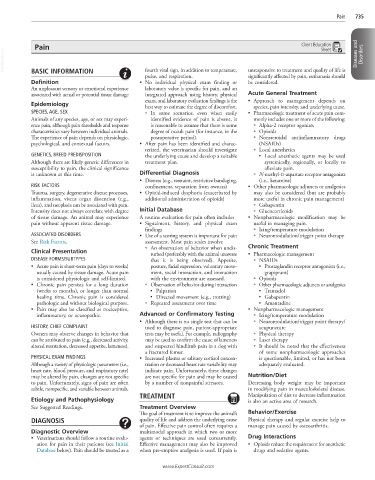Page 1449 - Cote clinical veterinary advisor dogs and cats 4th
P. 1449
Pain 735
Pain Client Education
Sheet
VetBooks.ir Diseases and Disorders
BASIC INFORMATION
fourth vital sign, in addition to temperature,
pulse, and respiration. unresponsive to treatment and quality of life is
significantly affected by pain, euthanasia should
Definition • No individual physical exam finding or be considered.
An unpleasant sensory or emotional experience laboratory value is specific for pain, and an
associated with actual or potential tissue damage integrated approach using history, physical Acute General Treatment
exam, and laboratory evaluation findings is the • Approach to management depends on
Epidemiology best way to estimate the degree of discomfort. species, pain intensity, and underlying cause.
SPECIES, AGE, SEX ○ In some scenarios, even when easily • Pharmacologic treatment of acute pain com-
Animals of any species, age, or sex may experi- identified evidence of pain is absent, it monly includes one or more of the following:
ence pain, although pain thresholds and response is reasonable to assume that there is some ○ Alpha-2 receptor agonists
characteristics vary between individual animals. degree of occult pain (for instance, in the ○ Opioids
The experience of pain depends on physiologic, postoperative period). ○ Nonsteroidal antiinflammatory drugs
psychological, and contextual factors. • After pain has been identified and charac- (NSAIDs)
terized, the veterinarian should investigate ○ Local anesthetics
GENETICS, BREED PREDISPOSITION the underlying cause and develop a suitable ■ Local anesthetic agents may be used
Although there are likely genetic differences in treatment plan. systemically, regionally, or locally to
susceptibility to pain, the clinical significance alleviate pain.
is unknown at this time. Differential Diagnosis ○ N-methyl-D-aspartate receptor antagonists
• Distress (e.g., restraint, restrictive bandaging, (i.e., ketamine)
RISK FACTORS confinement, separation from owners) • Other pharmacologic adjuncts or analgesics
Trauma, surgery, degenerative disease processes, • Opioid-induced dysphoria (exacerbated by may also be considered (but are probably
inflammation, viscus organ distention (e.g., additional administration of opioids) more useful in chronic pain management)
ileus), and neoplasia can be associated with pain. ○ Gabapentin
Intensity does not always correlate with degree Initial Database ○ Glucocorticoids
of tissue damage. An animal may experience A routine evaluation for pain often includes • Nonpharmacologic modification may be
pain without apparent tissue damage. • Signalment, history, and physical exam useful in managing pain.
findings ○ Icing/temperature modulation
ASSOCIATED DISORDERS • Use of a scoring system is important for pain ○ Neuromodulation/trigger point therapy
See Risk Factors. assessment. Most pain scales involve
○ An observation of behavior when undis- Chronic Treatment
Clinical Presentation turbed (preferably with the animal unaware • Pharmacologic management
DISEASE FORMS/SUBTYPES that it is being observed). Appetite, ○ NSAIDs
• Acute pain is short-term pain (days to weeks) posture, facial expression, voluntary move- ■ Prostaglandin receptor antagonists (i.e.,
usually caused by tissue damage. Acute pain ment, social interaction, and interaction grapiprant)
is considered physiologic and self-limited. with the environment are assessed. ○ Opioids
• Chronic pain persists for a long duration ○ Observation of behavior during interaction ○ Other pharmacologic adjuncts or analgesics
(weeks to months), or longer than normal ■ Palpation ■ Tramadol
healing time. Chronic pain is considered ■ Directed movement (e.g., trotting) ■ Gabapentin
pathologic and without biological purpose. ○ Repeated assessment over time ■ Amantadine
• Pain may also be classified as nociceptive, • Nonpharmacologic management
inflammatory, or neuropathic. Advanced or Confirmatory Testing ○ Icing/temperature modulation
• Although there is no single test that can be ○ Neuromodulation/trigger point therapy/
HISTORY, CHIEF COMPLAINT used to diagnose pain, patient-appropriate acupuncture
Owners may observe changes in behavior that tests may be useful. For example, radiography ○ Physical therapy
can be attributed to pain (e.g., decreased activity, may be used to confirm the cause of lameness ○ Laser therapy
altered mentation, decreased appetite, lameness). and suspected hindlimb pain in a dog with ○ It should be noted that the effectiveness
a fractured femur. of some nonpharmacologic approaches
PHYSICAL EXAM FINDINGS • Increased plasma or salivary cortisol concen- is questionable, limited, or has not been
Although a variety of physiologic parameters (i.e., tration or decreased heart rate variability may adequately evaluated.
heart rate, blood pressure, and respiratory rate) indicate pain. Unfortunately, these changes
may be altered by pain, changes are not specific are not specific for pain and may be caused Nutrition/Diet
to pain. Unfortunately, signs of pain are often by a number of nonpainful stressors. Decreasing body weight may be important
subtle, nonspecific, and variable between animals. in modifying pain in musculoskeletal disease.
TREATMENT Manipulation of diet to decrease inflammation
Etiology and Pathophysiology is also an active area of research.
See Suggested Readings. Treatment Overview
The goal of treatment is to improve the animal’s Behavior/Exercise
DIAGNOSIS quality of life and address the underlying cause Physical therapy and regular exercise help to
of pain. Effective pain control often requires a manage pain caused by osteoarthritis.
Diagnostic Overview multimodal approach in which two or more
• Veterinarians should follow a routine evalu- agents or techniques are used concurrently. Drug Interactions
ation for pain in their patients (see Initial Effective management may also be improved • Opioids reduce the requirement for anesthetic
Database below). Pain should be treated as a when pre-emptive analgesia is used. If pain is drugs and sedative agents.
www.ExpertConsult.com

